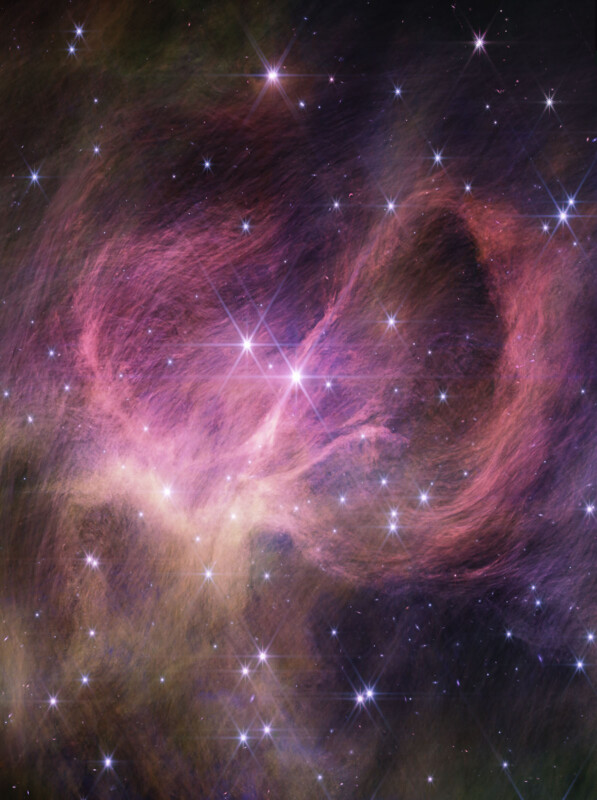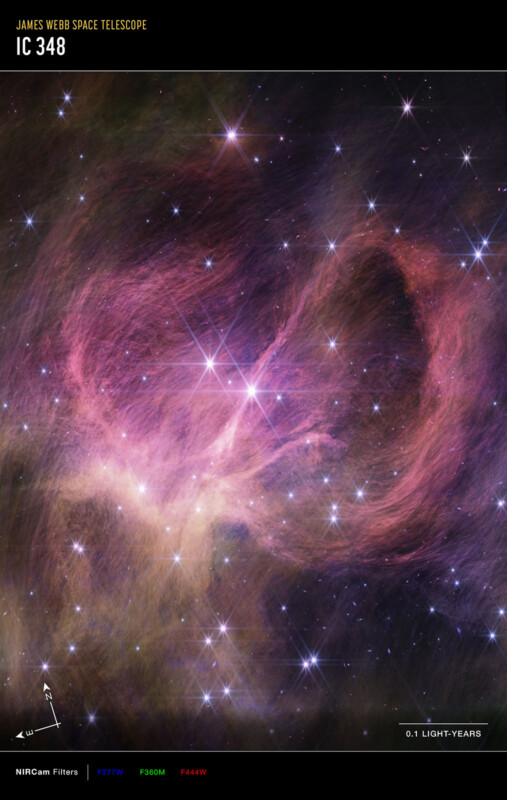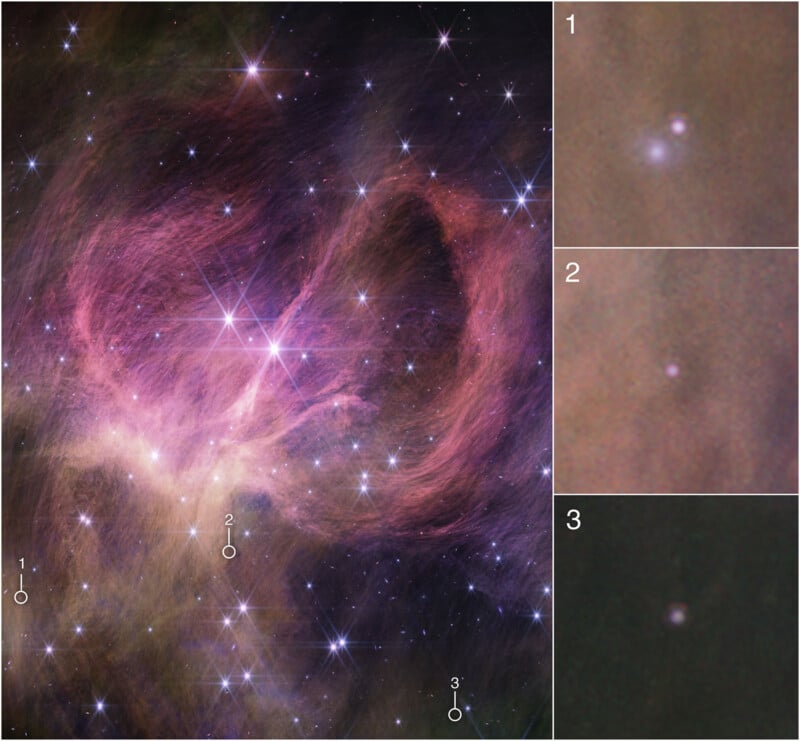
The wispy curtains filling the image are interstellar material reflecting the light from the cluster’s stars – what is known as a reflection nebula. The material also includes carbon-containing molecules known as polycyclic aromatic hydrocarbons, or PAHs. The bright star closest to the center of the frame is actually a pair of type B stars in a binary system, which are the most massive stars in the cluster. Winds from these stars may help sculpt the large loop seen on the right side of the field of view.
Even as telescopes and observatories uncover more details about space, it remains mysterious. One puzzle revolves around the “smallest object that can form in a star-like manner,” according to NASA. With the help of the James Webb Space Telescope, scientists have identified a new record holder for that category: a free-floating brown dwarf.
Brown dwarfs are objects that essentially fall in between stars and plants. “They form like stars, growing dense enough to collapse under their own gravity, but they never become dense and hot enough to begin fusing hydrogen and turn into a star,” NASA explains. At the small end, brown dwarfs are most similar to giant planets with a weight a few times that of Jupiter.

The north and east compass arrows show the orientation of the image on the sky. Note that the relationship between north and east on the sky (as seen from below) is flipped relative to direction arrows on a map of the ground (as seen from above).
The scale bar is labeled in light-years, which is the distance that light travels in one Earth-year. (It takes 0.1 years for light to travel a distance equal to the length of the scale bar.) One light-year is equal to about 5.88 trillion miles or 9.46 trillion kilometers. The field of view shown in this image is approximately 0.5 light-years across and 0.8 light-years high.
This image shows invisible near-infrared wavelengths of light that have been translated into visible light. The color key shows which NIRCam filters were used when collecting the light. The color of each filter name is the visible light color used to represent the infrared light that passes through that filter.
To find the tiny brown dwarfs, Astronomer Kevin Luhman and his colleague, Catarina Alves de Oliveira, studied the star cluster IC 348, roughly 1,000 light-years away in the Perseus star-forming region. At five million years old, it is a relatively young cluster. Because of the young age, any brown dwarfs would still be glowing from the heat of their formation and be relatively bright in infrared light.
The team first looked at the center of the cluster using Webb’s NIRCam (Near-Infrared Camera). They looked for brown dwarfs based on their brightness and colors. Then, they looked closer at the most promising subjects with Webb’s NIRSpec (Near-Infrared Spectrograph) microshutter array.
Webb’s infrared sensitivity was critical for this research, as it allowed the scientists to detect fainter objects than telescopes on the ground. The telescope’s sharpness was also key, as it helped them to differentiate between red objects that were brown dwarfs versus “blobby background galaxies,” says NASA.

The wispy curtains filling the image are interstellar material reflecting the light from the cluster’s stars — what is known as a reflection nebula. The material also includes carbon-containing molecules known as polycyclic aromatic hydrocarbons, or PAHs. The bright star closest to the center of the frame is actually a pair of type B stars in a binary system, which are the most massive stars in the cluster. Winds from these stars may help sculpt the large loop seen on the right side of the field of view.
The team found three possible targets, each weighing three to eight Jupiter masses with surface temperatures between 1,500 and 2,800 degrees Fahrenheit. According to computer models, the smallest one weighs only three to four times Jupiter.
Though the discovery is exciting, it raises new questions. It isn’t clear how such a small brown dwarf could even form. “A heavy and dense cloud of gas has plenty of gravity to collapse and form a star,” NASA explains. “However, because of its weaker gravity, it should be more difficult for a small cloud to collapse to form a brown dwarf, and that is especially true for brown dwarfs with the masses of giant planets.”
“It’s pretty easy for current models to make giant planets in a disk around a star,” said Catarina Alves de Oliveira of ESA (European Space Agency), principal investigator on the observing program. “But in this cluster, it would be unlikely this object formed in a disk, instead forming like a star, and three Jupiter masses is 300 times smaller than our Sun. So we have to ask, how does the star formation process operate at such very, very small masses?”
Beyond offering clues about how stars form, tiny brown dwarfs can also provide insights on exoplanets. The smallest brown dwarfs overlap with the largest exoplanets, so it seems reasonable that there should be some similar properties. Luckily, “a free-floating brown dwarf is easier to study than a giant exoplanet since the latter is hidden within the glare of its host star,” says NASA.
For example, two of the brown dwarfs found in this most recent survey “show the spectral signature of an unidentified hydrocarbon, which is a molecule that contains both hydrogen and carbon atoms. The NASA Cassini mission detected that same infrared signature in the atmospheres of Saturn and Titan, its moon, as well as in the gas between stars (interstellar medium).
“This is the first time we’ve detected this molecule in the atmosphere of an object outside our solar system,” explained Alves de Oliveira. “Models for brown dwarf atmospheres don’t predict its existence. We’re looking at objects with younger ages and lower masses than we ever have before, and we’re seeing something new and unexpected.”
Due to the size of the objects, which is within the mass range of giant planets, it is possible they aren’t actually brown dwarfs. They could instead be rogue planets ejected from planetary systems. The team cannot rule this out but contends they are more likely to be brown dwarfs.
The theory of an ejected planet isn’t likely because such planets are uncommon compared to planets with smaller masses. Also, “most stars are low-mass stars, and giant planets are especially rare among those stars. As a result, it’s unlikely that most of the stars in IC 348 (which are low-mass stars) are capable of producing such massive planets,” NASA states. Finally, the young age of the cluster means it is unlikely there has been enough for a giant planet to form and be ejected from its system.
Further research and discoveries will help clarify the status of these objects. Theories suggest that rogue planets are more likely to be found in the outskirts of a star cluster,” NASA notes, “So expanding the search area may identify them if they exist within IC 348.”
These observations were taken as part of Guaranteed Time Observation program 1229. The results were published in The Astronomical Journal.
Image credits: NASA, ESA, CSA, STScI, Kevin Luhman (PSU), Catarina Alves de Oliveira (ESA)
